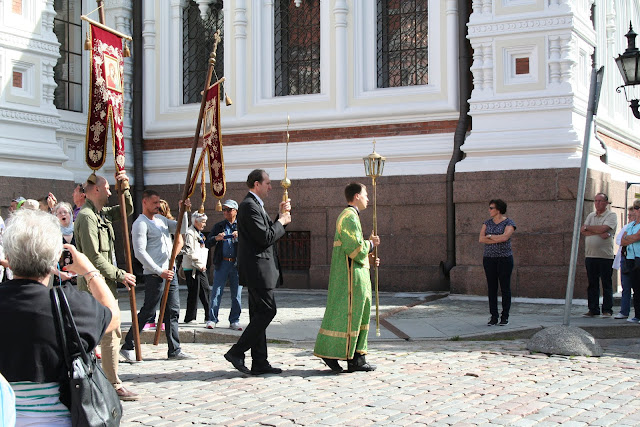Tallinn's old town is surrounded by a medieval city wall dotted with defensive towers.
 |
| A model of Tallinn's towers and city wall - Fat Margaret is on the far left, Toompea is just out of sight on the top right and the town hall is in the centre |
 |
| A map showing the wall and towers |
Here's some of our shots of the city walls:
 |
| City walls and tower |
 |
| City walls and construction |
 |
| Inside of the city walls |
 |
| Inside of city walls |
 |
| Walk inside the city walls |
 |
| City wall and Tallitorn (Stable Tower) |
 |
| An interesting shot - the new skyscrapers through the old city walls |
 |
| City walls and towers (this is Neitsitorn - Maiden's Tower) |
Neitsitorn (Maiden's Tower)
Neitsitorn is a tower first mentioned in 1373, it houses a small museum and a walk along the walls.
 |
| Neitsitorn info |
 |
| Monk Statue outside Neitsitorn |
 |
| Monk Statue outside Neitsitorn |
 |
| Monk Statue outside Neitsitorn |
 |
| Inside of the city walls leading to Neitsitorn |
 |
| View from the city walls |
 |
| View down to Neitsitorn |
The next tower was the slightly humorously sounding Kiek in De Kok, which literally means Peek into the Kitchen - a Germany tower name used in a few places for tall defensive towers.
 |
| Kiek in De Kok |
 |
| View from Kiek in De Kok |
 |
| A worrying emergency escape from the higher levels of Kiek in De Kok |
 |
| Leads to a pretty serious drop |
 |
| View from Kiek in De Kok |
Toompea Castle
Our next stop was Toompea Castle. This castle has been in use since the 9th century and is now used as a house of Parliament.
 |
| Tower and side wall of Toompea Castle |
 |
| Front facade of the Castle |
 |
| Lower side walls of the castle |
 |
| A weird mix of house, castle and tower |
Alexander Nevsky Cathedral
Directly across from Toompea Castle was the very impressive Alexander Nevsky Cathedral. Its an Orthodox cathedral build in 1894:
The cathedral was crowded when we first arrived as a ceremony was taking place.
 |
| Entry to the Cathedral |
 |
| Alexander Nevsky Cathederal |
 |
| Ceremony |
 |
| Procession |
 |
| Interior |
Photos weren't allowed to be taken in the church, but here's a stock shot from Wikipedia:
There were several other impressive churches we visited:
St Olaf's Church and Tower
 |
| St Olaf's Church and Tower |
This church and tower were built in the 12th century. It has a total height of 125m and can easily been seen from sea on approach.
 |
| The tower visible over the city |
St Nicholas' Church
This church was built in the 13th century and was partly destroyed in World War II. It has been restored and houses an art museum:
 |
| St Nicholas' Spire |
 |
| St Nicholas' Church |
 |
| St Nicholas' Spire |
Saint Mary's Cathedral Toomkirk (Dome Church)
This church was built in the 13th century and was the only building to survive the fire in the 17th century.
 |
| Saint Mary's |
 |
| Saint Mary's |
Town Hall
The Tallinn Town Hall was built in 1404 and is the oldest Town Hall in the Baltic Region and Scandinavia.
 |
| Town Hall |
 |
| Dragon gargoyle |
Freedom Square
Freedom square celebrates the Estonian War of Independance 1918-1920. During Soviet Occupation, the square was known as Victory Square:
 |
| Looking down over victory square |
 |
| Path down to Freedom Square |
 |
| Path from Freedom Square |
 |
| Top of the Freedom pillar |
 |
| Looking out over Freedom Square |
Katariina Kaik (St Catherine's Passage)
This is a medieval passageway through Tallinn:
 |
| Entering the passage |
Hanging on the walls of the passage were Tombstones from the Church of St Catherine of Alexandria. The stones were from members of the Magistrates of Tallinn, the Brotherhood of Blackheads and the Great Guild.
The tombstones in order were:
1 - Kunigunde Schotelmund (1381)
2 - HR Adolfus / MR Adolfus (1330) Arnoldus De Hove (1371)
3 - Perek Bremen, Fam Bremen (1388)
4 - Diderick Bocholt (1501)
5 - Lodovicus De Holte (1437)
6 - Berent Pael (1503)
7 - Hinricus Cocus (1385)
8 - Johan Oldendorp (1448)
9 - Tundatu Isik / Unknown (1468)
10 - Tidemanus De Hereke (1488)
11 - Hans Verlink (1470)
12 - Hans Fient (1425)
 |
| Tombstones 1 and 2 |
 |
| Tombstones 3,4 and 5 |
|
|
 |
| Tombstones 1-5 |
 |
| Tombstones 3 -11 |
 |
| Tombstone 12 |
 |
| Ornamentation on the tombstone |
 |
| St Catherine's Passage |
 |
| St Catherine's Passage |
Medieval Torture Museum
We did a quick visit to the Medieval Torture Museum. It was fairly expensive and was only two rooms of replica equipment. It was interesting, but not really worth the price:
 |
| Ryan Air Aircraft seat (luxury version as its a little wider) |
 |
| Replica of our room on the ferry |
 |
| Medieval Torture Museum - that fan looks pretty nasty! |
 |
| Medieval Torture Museum |












































































